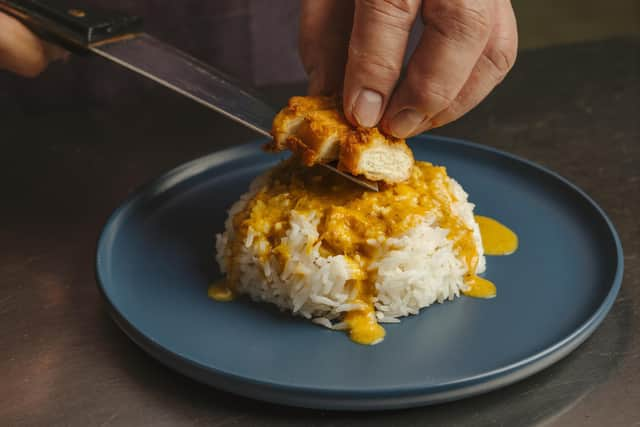COP27: What is lab-grown meat? The dish currying favour at COP27 in Egypt - but could it come to Scotland?
Chicken curry is on the menu. But not just any chicken curry. And no, it’s not from that well-known high-street brand – not yet, anyway. This chicken curry is made from meat grown in a tank. No birds died for the dish.
The meal, being served up at the COP27 climate summit, is a real taste of things to come. It is just one example in a long list of possibilities for the rapidly developing cultivated meat industry, which is being seen as a great hope for mass food production in the future. So what could this mean for our fish supper or Sunday roast?
Advertisement
Hide AdAdvertisement
Hide AdThe world’s seemingly insatiable appetite for meat is causing deep damage to the planet and cannot continue, according to scientists. Livestock farming has high environmental impacts, including deforestation, heavy use of water and production of climate-warming methane and nitrogen.
It is also beset by animal welfare issues and relies heavily on chemicals and medicines, which can drive problems of antibiotic resistance. Simultaneously, over-fishing is threatening seafood stocks, while intensive fish-farming has been blamed for pollution and spread of pests and diseases to wild species.
Plant-based diets are considered the most eco-friendly, with many people cutting out meat entirely or following a ‘climatarian’ regime, where the proportion of meat is very low. But lab-grown meat – genuine animal protein that is created in a special brewing tank – solves a number of these problems. It does not require vast tracts of land of sea for pastures and pens and can be made anywhere, such as in big cities, close to the mouths it is feeding.
The first ever artificially reared meat was served up as a burger in 2013. It didn’t taste bad, but the $300,000 [£256,044] price tag was hard to swallow. Now, though, technology has advanced and costs are coming down.
Singapore is the only country where cultivated meat is licensed for commercial sale, since 2020. It’s still a very niche market, with only one product available – mainly at private events – and sold at a loss. However, all that could soon change.


Singapore-based Mirte Gosker is managing director of the Asia Pacific branch of the Good Food Institute (GFI), an international non-profit that works to advance sustainable proteins, including cultivated meat. She is part of a team in Egypt, attending and hosting events at the United Nations conference.
She said she believed the cultivated meat industry can play a key role in helping feed the world’s rapidly expanding population while reducing the environmental impacts associated with farming, but more support is needed from governments and regulators to speed up development.
“People don’t eat meat from industrial animal agriculture because of how it is produced,” she said. “They eat meat in spite of how it is produced. And our research suggests a majority of consumers in France, Germany, Italy and Spain want to see alternatives to conventional animal agriculture developed.”
Advertisement
Hide AdAdvertisement
Hide AdThe number of people who have bought and eaten cultivated meat in Singapore remains miniscule – estimates suggest around 1,000 so far – because only tiny quantities are being produced. But the country is performing an important service, Gosker says, “providing a proof of concept” and “demonstrating that cultivated meat can deliver all of the tastes and flavours mainstream meat-eating consumers expect, without industrially farming animals and chopping down the rainforest”. She added: “It’s simply a smarter way to make meat.”


The technique could also help solve other troubles for the meat industry. Gosker said: “Just before Covid began, China had to cull 40 per cent of its pig herd due to a swine flu outbreak, which also caused pork prices to soar.
“By contrast, cultivated meat is slaughter-free, eliminates the risk of spreading zoonotic disease and could significantly reduce potential contamination by pathogens like E.coli, making it a more secure and sustainable food source. Between a climate crisis that is ravaging traditional agricultural systems and the lingering effects of the latest pandemic, humanity badly needs a stable and healthy food supply, resilient in the face of future disruptions.”
Maarten Bosch, chief executive of Netherlands-based Mosa Meat, which produces tank-reared beef, is also in Egypt. He said the debut of cultivated meat at the summit this year marks “a historic breakthrough”.
He said: “Our goal is to help solve some of the most pressing issues associated with current industrial beef production and help combat the climate crisis by offering new ways to satisfy the world’s demand for beef. It’s a great step forward to see increased attention on agrifood reform – and specifically cultivated beef – at COP27.”


Mosa Meat is focusing on beef products because cattle have such an “outsized” hit on the earth. “Cows are highly inefficient,” he said. “They convert only 15 per cent of edible food crops into meat that humans can eat.
“Compared with slaughtered beef, the most recent analysis shows that cultivated beef production could reduce climate impact by 92 per cent, air pollution by 93 per cent, use 95 per cent less land and 78 per cent less water.”
Gosker has already sampled a variety of cultivated meat and seafood, including chicken, duck, beef, grouper, crab and fish maw – a Chinese delicacy. “Each product is historic in its own right,” she said.
Advertisement
Hide AdAdvertisement
Hide AdBut its green credentials make it all the more satisfying. “Every time I take a bite of cultivated meat, I taste hope,” she said. “I think – this is the future, this is how we can continue to enjoy the foods we love while saving the planet for our children and theirs.”
Comments
Want to join the conversation? Please or to comment on this article.